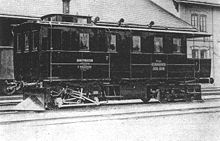Wheelset
A wheel set is a non-driven wheel set of a locomotive or a railcar . The term running axle is also used in the specialist literature and is to be regarded as equivalent. In addition, all wheels on a bicycle are collectively referred to as a wheel set.
In contrast to this, a drive wheel set (driving axle) or a coupled wheel set (coupled axle) is a driven wheel set. In the case of locomotives and railcars, the arrangement of the running axles is described using the axle formula .
The use of whether a wheel set or a running axle depends on the context, since locomotives are talking about the wheel sequence and not the wheel set sequence . If the component is referred to on its own, but the term wheel set is used, and accordingly wheelset apply.
Tasks of the running axis
They carry part of the vehicle's mass so that the permissible axle load is not exceeded, and they take control of the vehicle on the track . Therefore, their number depends on the service weight and the maximum permitted speed of the vehicle.
Use of running axles


Railcars are equipped with running axles if no all-axle drive is required to fulfill the operating program. This simplifies the vehicle design, particularly in the case of vehicles driven by diesel mechanics and hydraulics. Running axles were only used in older locomotives to carry their mass and to guide them on the track at high speeds. In modern locomotives, only driving axles are housed in bogies so that the entire mass of the vehicle contributes to the adhesion . The bogies guide the vehicle safely on the track even at high speeds .
In standard design steam locomotives, wheel sets in front of the coupling axles (therefore also called "forerunners") reduce the front overhanging masses in addition to guiding the vehicle on the track, in particular in the form of cylinders with the internal control of the steam engine and the smoke chamber. Trailers or trailing axles support the standing boiler in the case of locomotives with a tender, which can thus be arranged with the ash box unhindered by the coupled wheel sets behind and wide above the frame. In particular, the construction of high-speed locomotives with a large drive and coupling wheel diameter is made easier. In the case of tank locomotives , rear running axles also serve to guide the journey with the tender ahead. In addition, they carry the mass of the supplies, their consumption in operation therefore has less of an effect on the available friction mass.
In contrast to coupled wheel sets, which have to be run parallel in the frame due to their function, which leads to a strong inclination of the end axes, especially in machines with many coupling axes and in tight bends, running axes can be installed radially adjustable to reduce wear. Supplemented by reset devices, this increases the guided length and thus the guidance in the track. It is also improved by distributing the executives over several axles, for example by using a running bogie or the connection of a running and a coupling axle in the form of a Krauss-Helmholtz steering frame .
See also:
- Bissel salmon
- Adam's axis
- Schwartzkopff-Eckhardt steering frame
- Krauss Lotter frame
- Luttermöller axle drive
- Delta towing frame
- Java bogie
literature
- Steam locomotive studies Volume 134 of the railway teaching library of the Deutsche Bundesbahn 2nd edition pages 482–487 (reprint from 1983 ISBN 3-9800684-2-0 )